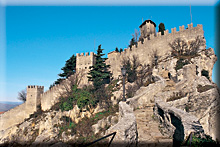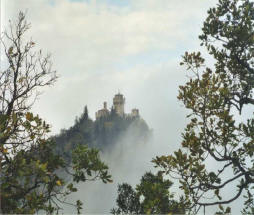|
||||||
|
Attractions
La Rocca
La Rocca, or more properly the Guaita, or First Tower, dates back to the 11th century, although it was given a few licks and spits in the 19th and 20th centuries. The structure was chipped straight out of the stone surface without recourse to foundations, and promptly pressed into service as a guard tower and refuge post. The entrance of the pentagonal structure displays the republic's baroque coat of arms, purloined from the Palazzo Publico. It also has a picture-book bell tower (as every fortress should) and, built a few years after the bell tower, a tower of penance - which always comes in handy when you're talking medieval punishment. Up until 1970 the Rocca was still a working prison, but these days tourists are free to roam unhindered around most of the fortress. |
|
Cesta
From La Rocca you can take a panoramic stroll across to the Second Tower, sometimes known as Cesta or Fratta. Built at an elevation of 756m (2480ft) on Mount Titano, it's the highest-standing of the fortresses, and dates back to the 13th century. It mirrors the pentagonal shape of La Rocca and, like that tower, was also used as a prison. You get the feeling that, for a small republic the size of a few suburbs, it sure had a lot of penal activity and penitence going on. The San Marino Museum of Antique Weapons is housed in what was formerly the guardrooms and castle-keepers' rooms. The collection of sharp pointy objects that constitute the quaint medieval notion of a killing machine includes swords, knives, lances, firearms, bows and crossbows. There's also armour to protect oneself from the sharp pointy objects. More than 500 objects follow the history of weaponry from the late 800s to medieval times. Other pieces of the collection, which in its entirety numbers over 1550 objects, can be found at the descriptively (albeit prolixly) named Centre for Studies on Weaponry from the Middle Ages to the 1900s at the nearby township of Borgo Maggiore. MontaleThe Third Tower (or Montale), like Cesta, dates back to the 13th century and, like the other two, is the familiar pentagon shape. Also, like the others, it was used as, surprise, surprise, a prison! Unlike the other prisons, though, this one has serious porridge going on - it's 8m (26ft) deep and is called 'the tower bottom'. Talk about rock bottom: you don't get much lower in life than the bottom of a deep dungeon in a tower fortress carved out of a rock face. Re-enforcing the disciplinary feel of the place, Montale looks out on a series of antique rocks placed together to form a primitive wall system that runs from Cesta to the old quarry. The quarry is the remains of the second town wall constructed in the 13th century. In fact the erstwhile citizens of San Marino built no less than three stone walls, all in different centuries, as protection. Over the years paranoia gave way to pragmatism and much of the stone walls was demolished to make way for city expansions. Basilica del SantoThe Basilica del Santo is the heart and spirit of both the city and the republic; inside are the reliquaries and religious artefacts of San Marino, the saint and founder of the eponymous republic. Although most of the basilica was constructed over the remains of the old parish in the middle of the 19th century, its origins hark back to a much earlier period. It once represented one of the first pre-Romanesque Christian monuments in Italy. Despite the loss of such an historic artefact, the basilica - built to the specifications of the Bolognese architect Antonio Serra - has its own neo-classical and Corinthian-columned attractions, as well as a bit of pre-medieval bric-a-brac left over from the old building. For instance, the solid bell tower was not just built in the 600s, it was rebuilt in the 600s, the same time that the throne of the Regent Captain was installed. The inside is made up of three aisles and seven altars, under one of which is a small urn containing the bones of San Marino. Part of his skull resides in a silver casket resting on a marble monument. Like elsewhere in Catholic Italy, the left-over parts of saints and holy men are revered as having the kind of thaumaturgic qualities that you just can't get from the best GP, surgeon or medical specialist |
|
Palazzo PublicoThe Palazzo Publico sits on the site of the old Domus Communis Magna, or Large Communal House (a common medieval household that puts the average shared student accommodation to shame), with best guestimates putting construction somewhere between 1380 and 1392. The first stone of the public palazzo was laid in 1884 to specifications by architectural designer Francesco Azzurri and, in a gesture that reflected the republic's architectural and cultural orgins, the work was undertaken by local stonecutters utilising stones extracted from the nearby Mount Titano caves. On the occasion of its inauguration, the now renowned speech on 'perpetual liberty' was delivered by local citizen and early republican Giosuč Carducci. The building is all richly carved stone, polygonal balconies, castellated battlements, and memento mories to the republic's saintly heroes, San Marino and San Leo. There are also a number of older art pieces that are worth a look: under the porch you'll find a marble bust of the architect Azzurri, sculpted by Giulio Tadolini; a great entrance hall with coats of arms and tombstones; a bust of Carducci; and a staircase that takes you up to the next floor where all gubernatorial needs are met by a 60-seat counsellor room, congress and hearing halls, and a voting room that looks out upon Pianello, or Piazza della Liberta Square.
Piazza della Liberta in turn overlooks a spectacular view of Montefeltro, the church of San Francesco, and La Rocca. |
|


